Santa
Croce - Table of Contents
............................... Architecture
Around the World
Nave and Chancel -
The Basilica of Santa Croce (Holy Cross)
Florence, Italy
On this page, below:
February 2020
photos
| Nave Visitors
enter the processional doors of a church at the back of the
church. The front of the church is at the other (eastern, towards
Jerusalem) end where the main altar is located.
Upon entering the building, there may be a small vestibule, then a narthex (where non-baptized Christians could stand). Between the narthex and the nave there is a wall where a door(s) is located. Often, above the door, near the top of the wall there is a rose window.  Nave Arcade ... View looking towards back of church at the back of the nave where there is a door and round rose window ... Pews cover much of the floor of the nave ... Pointed Gothic columns (colonnade) separate the nave from the side aisles where chapels (5 on each side in this church) are located.  Nave  Nave Rose window: Jesus's Removal from the Cross ... Three details below: 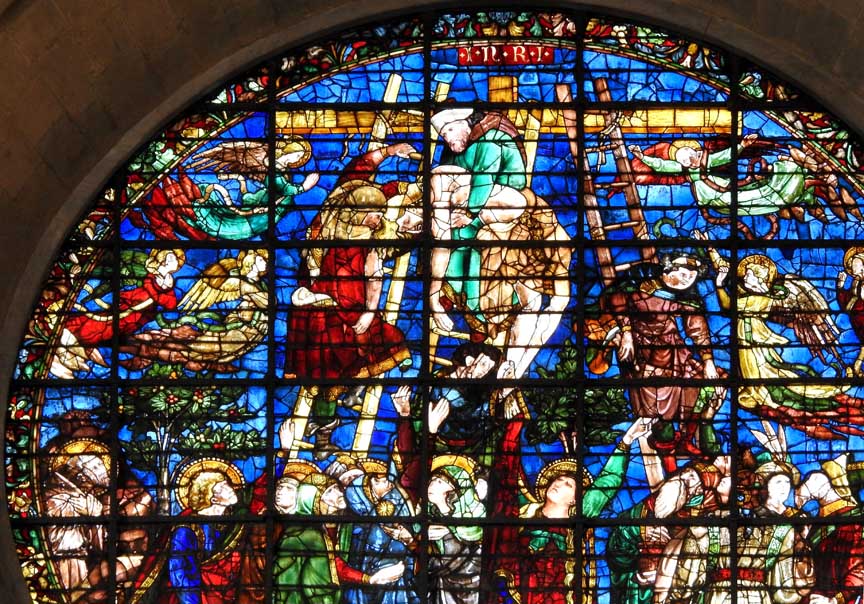 Nave Rose window: Jesus's Removal from the Cross  Nave Rose window: Jesus's Removal from the Cross 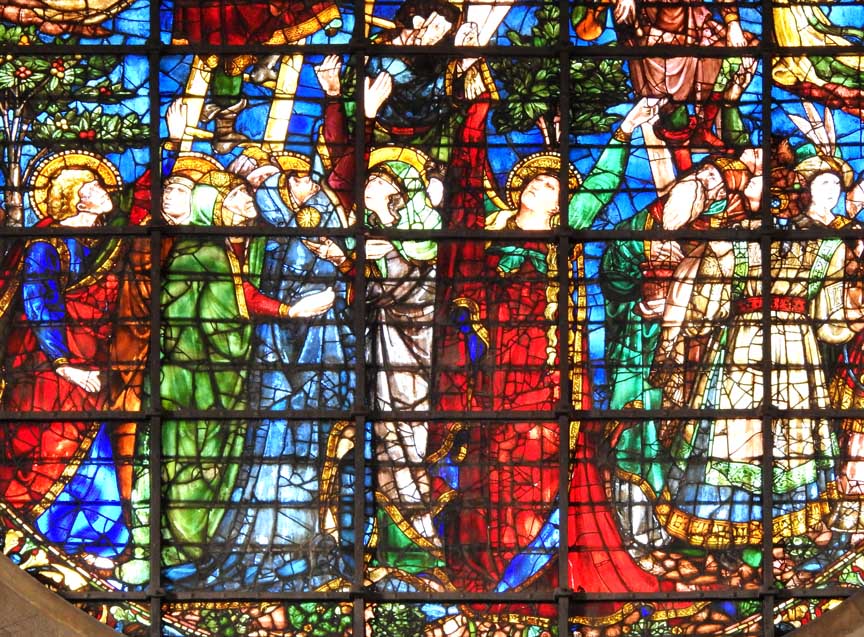 Nave Rose window: Jesus's Removal from the Cross 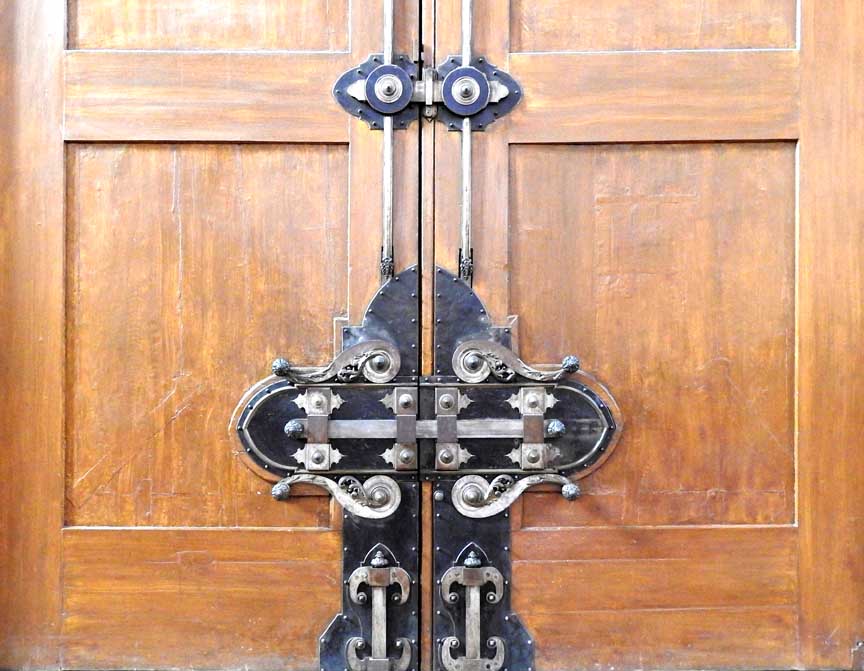 Nave Door hardware includes S scrolls and C scrolls 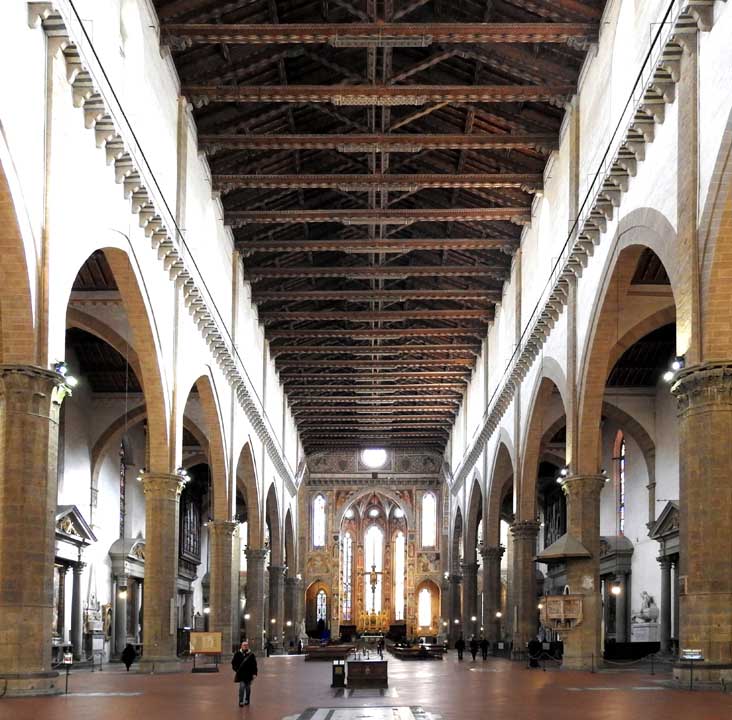 Nave View facing the main altar ... Note ceiling which is detailed below: 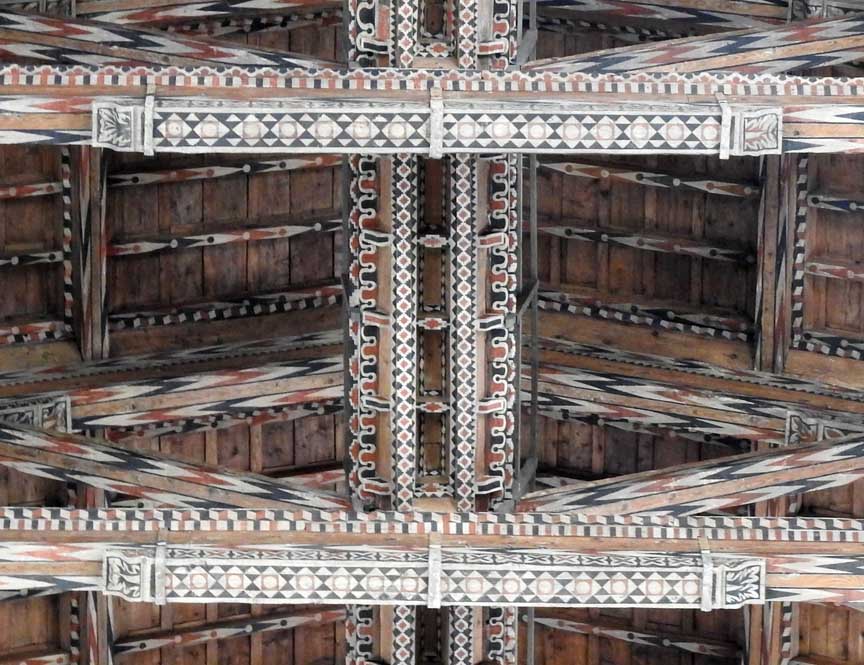 Nave Slightly pointed coffered wooden ceiling features painted geometric designs on tie beams ... This ceiling is quite different from other masonry European Gothic ceilings that are very pointed and ribbed 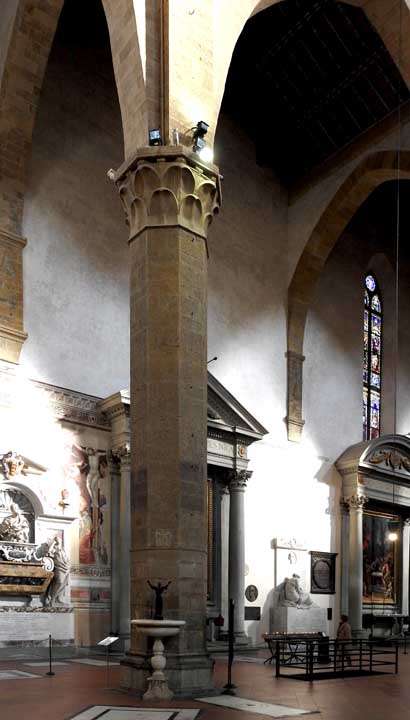 Nave Arcaded stone columns feature waterleaf capitals ... Columns separate center nave from side aisles where chapels, five on each side, are located ... Chapels in American churches are usually separate rooms; in Europe, chapels are separated into bays ... Note floor tombstones 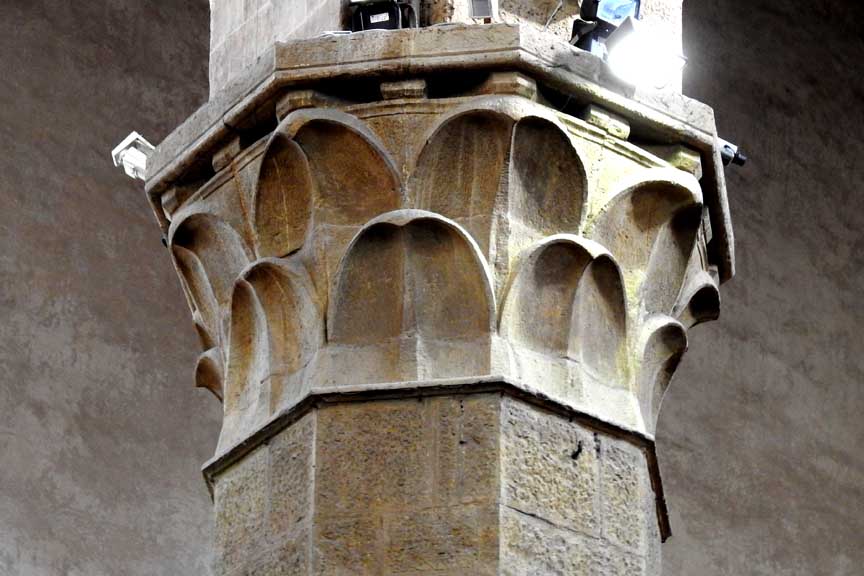 Nave Waterleaf capital ... During the Renaissance, columns will be much more complex and imitate mostly Greek or Roman Corinthian columns ... The first use of Corinthian columns in a church occurred in the Basilica of San Lorenzo designed by Filippo Brunelleschi 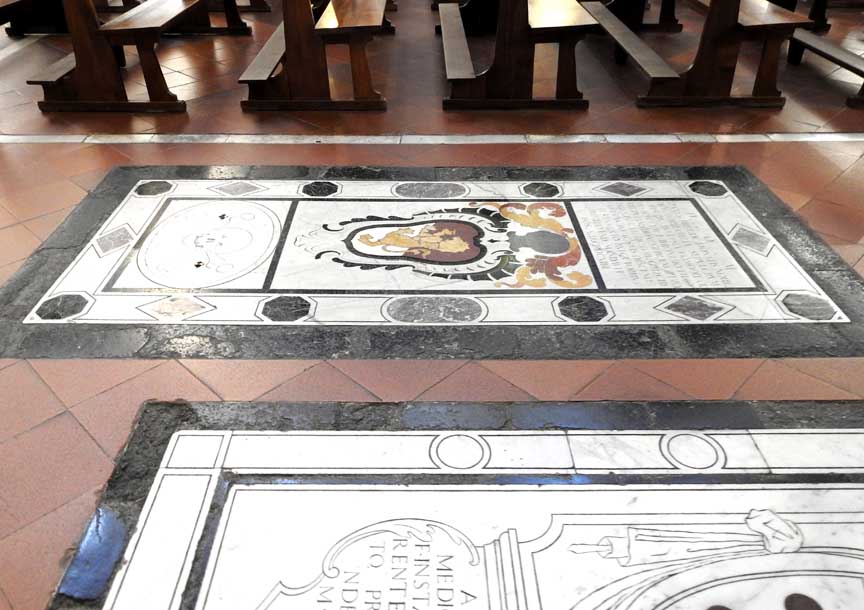 Nave Marble mosaic floor tombstones  Nave Polychromatc marble mosaic floor tombstone design 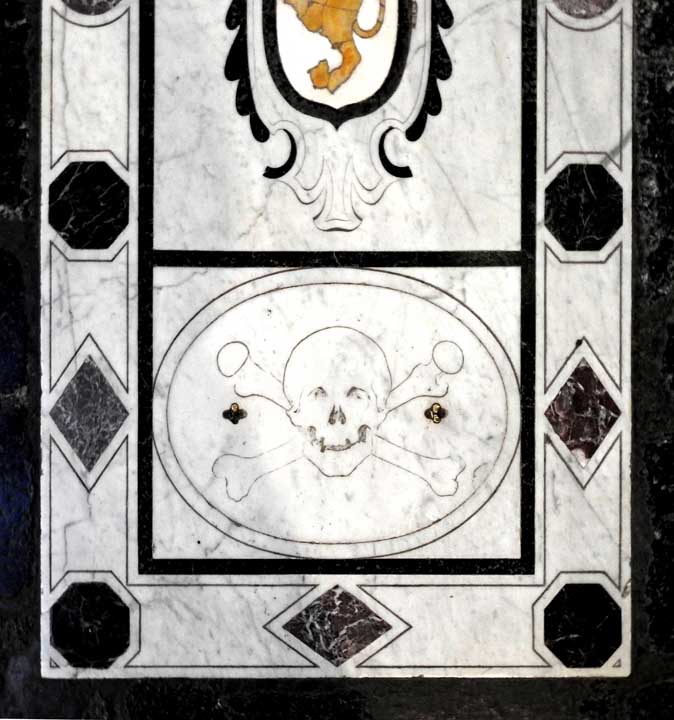 Nave Marble floor tombstone 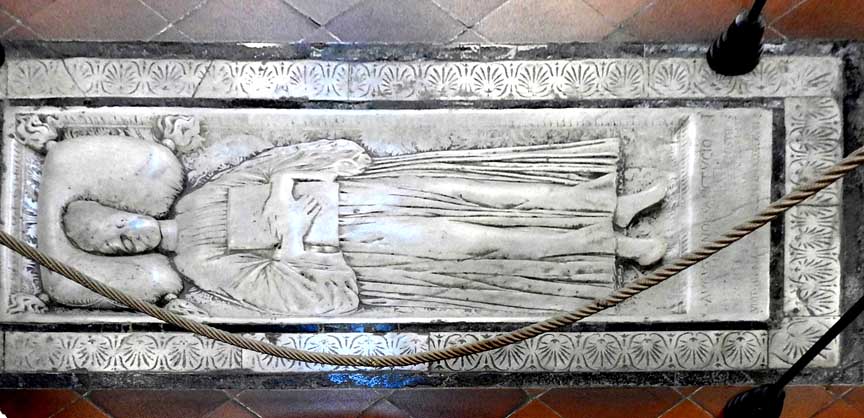 Nave Floor carved marble tombstone 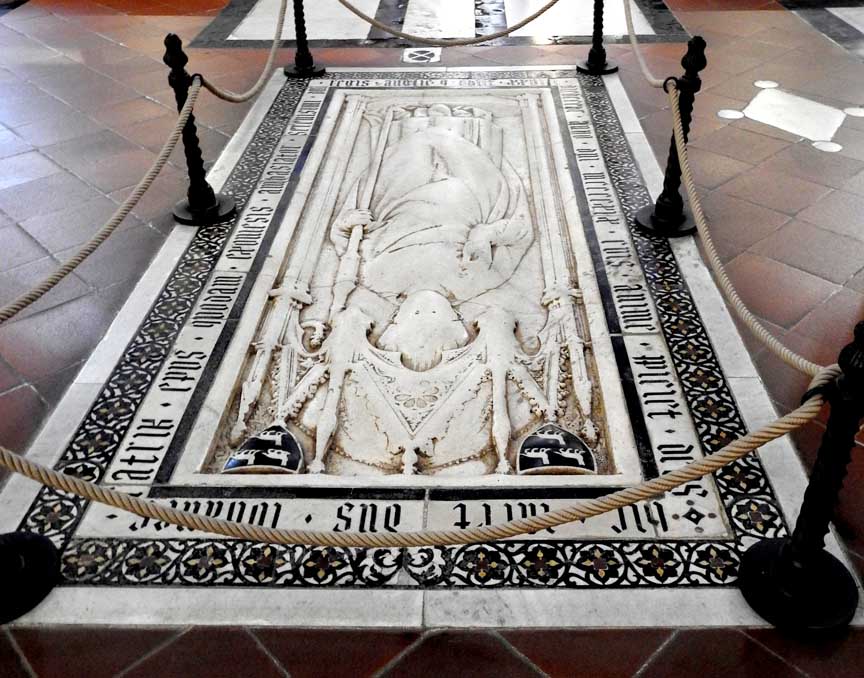 Nave Floor carved marble tombstone  Nave Prie dieu ... Three details below: 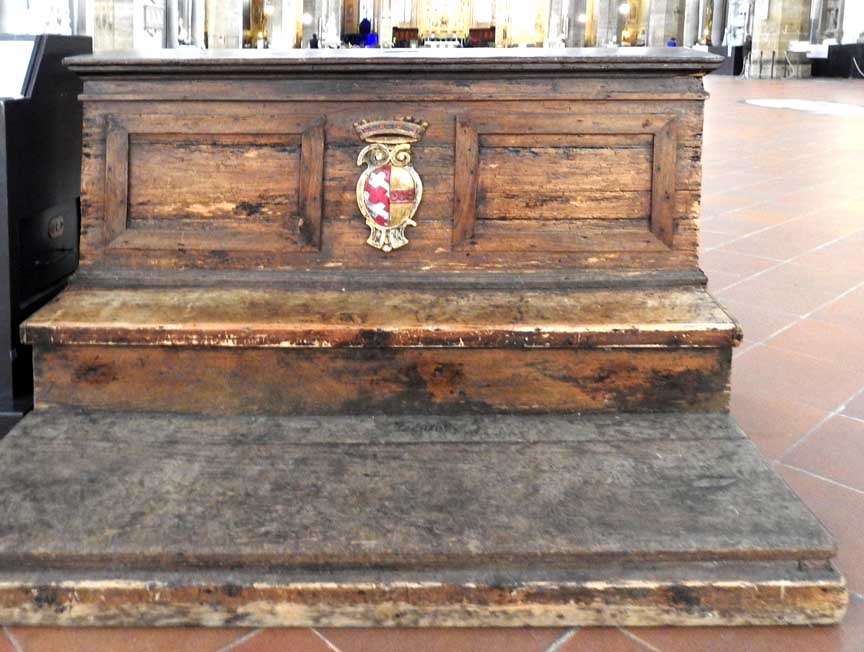 Nave Prie dieu 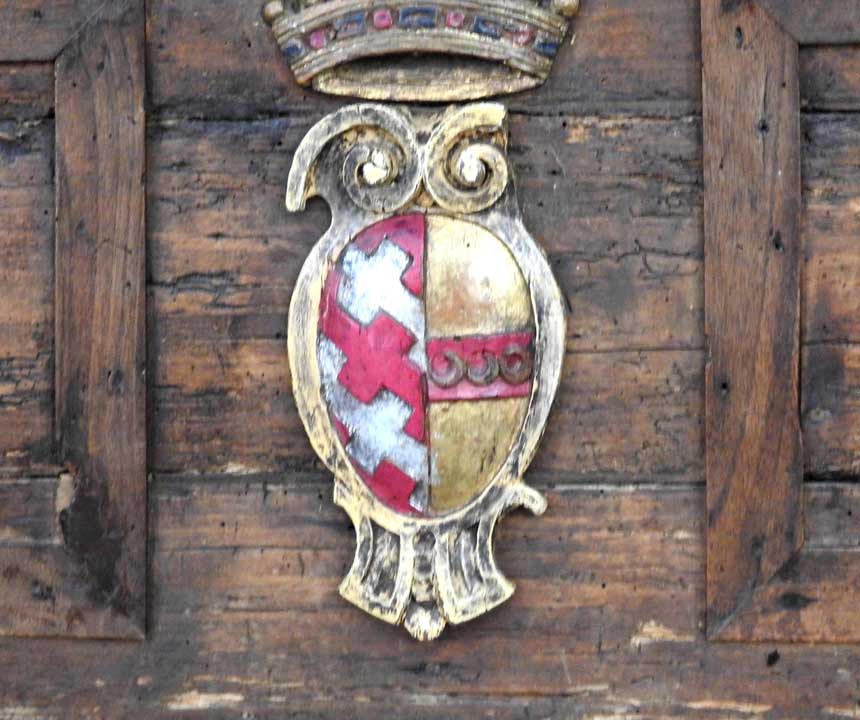 Nave Prie dieu ... Patron's emblem 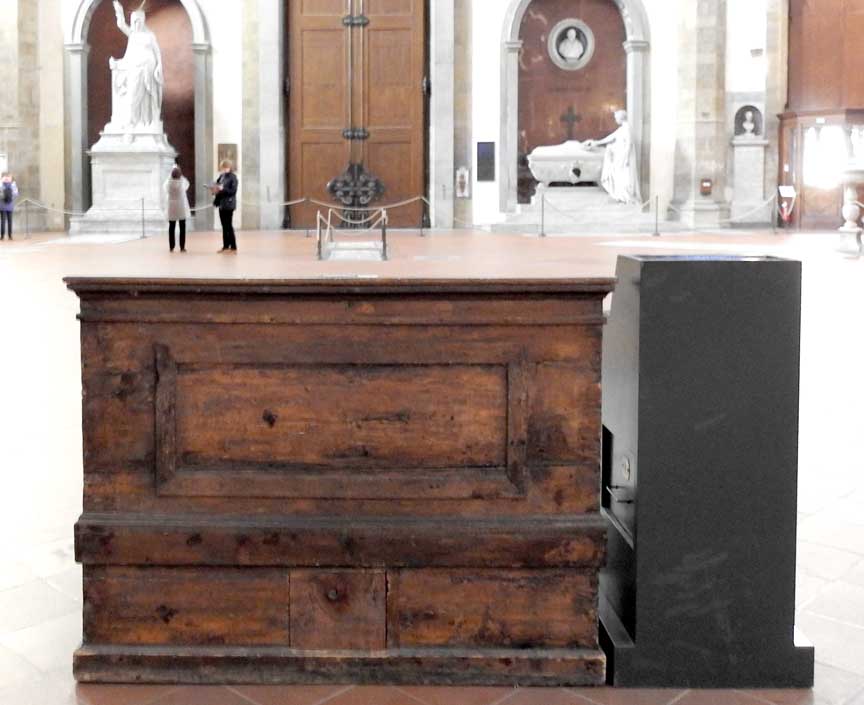 Nave Back of prie dieu ... Note nave back wall door 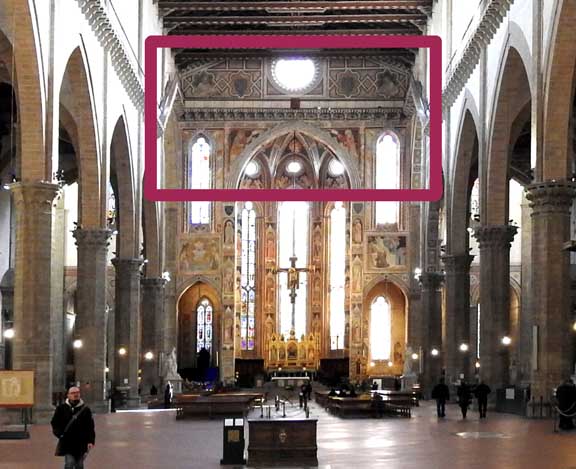 Nave View facing the main altar ... Selected area detailed below: 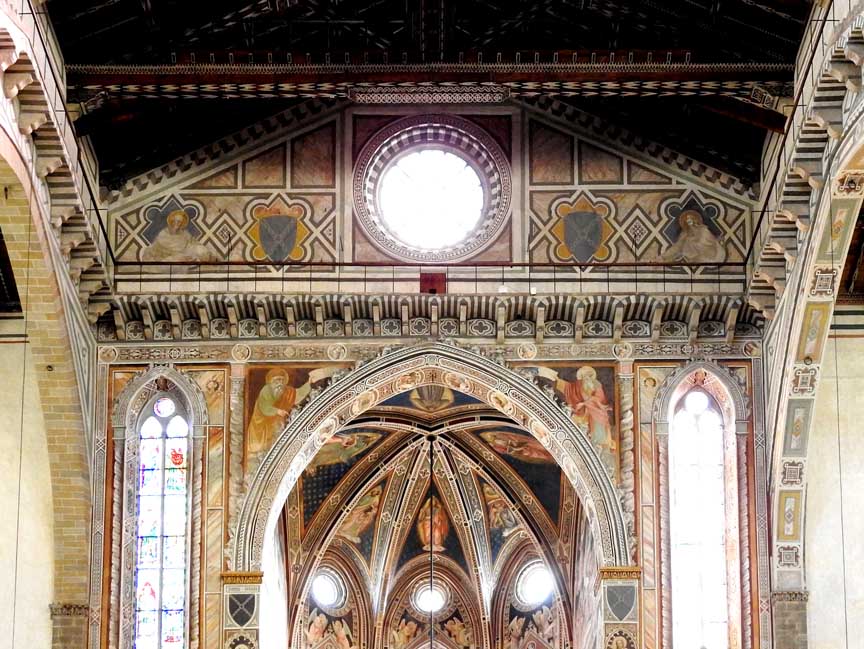 Nave Frieze and round stained glass window (sunlight-filled in the photo) are located on the front wall of the nave ... Chancel in background of recessed apse ... The window is detailed below:  Nave Florence flear-de-lis emblems ... Hand stigmata of Jesus and St. Francis of Assisi ... Clearly a modern window  Nave Left side of the painted Frieze flanking the center stained glass window |
| Rood A
rood crucifix
hangs between the nave
and the chancel
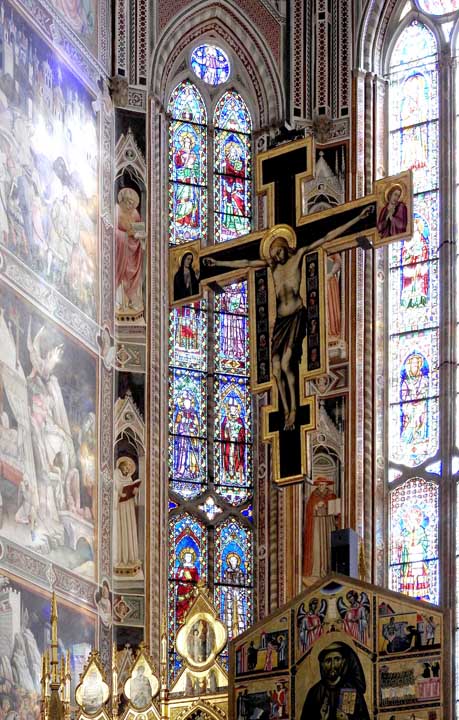 Rood Crucifix By Cimabue Year : 1287–1288 Medium : Distemper on wood panel Dimensions: 448 cm × 390 cm (176 in × 150 in) "The
Crucifix by Cimabue at Santa Croce (c. 1265) is a wooden crucifix,
painted in distemper, attributed to the Florentine painter and
mosaicist Cimabue, one of two large crucifixes attributed to him. The
work was commissioned by the Franciscan friars of Santa Croce and is
built from a complex arrangement of five main and eight ancillary
timber boards. It is one of the first Italian artworks to break from
the late medieval Byzantine style and is renowned for its technical
innovations and humanistic iconography.
"The gilding and monumentality of the cross link it to the Byzantine tradition. Christ's static pose is reflective of this style, while the work overall incorporates newer, more naturalistic aspects "The crucifix was installed in the church of Santa Croce at the end of the thirteenth century and remained there until 1966 when the banks of the Arno river burst and flooded Florence. Thousands of artworks were damaged or destroyed; the Crucifix lost 60% of its paint. It had suffered earlier flood damage in 1333 and 1557. In 1966 it was on display in the lower Museo dell' Opera, which is at a lower elevation and closer to the waterline than the Santa Croce church, where it was located during earlier floods. The water level reached the height of Christ's halo and took large tracts of paint when it retreated. The water deposited oil, mud and naphtha on the wood frame, which further swelled from soakage, forcing the panel to expand and bend, cracking the paint-work. A team of restorers led by conservators ... in Florence spent ten years reapplying paint. They worked in an almost pointillist manner, with the aid of computer modelling. The tiny specks of pigment floating around the piece were recovered with pliers by staff wading in the water after the torrents had subsided. The wooden frame had significantly weakened, and it was necessary to separate it from both the gesso and canvas to prevent buckling as the reapplied paint dried.[29] The restorers succeeded in returning the work close to its original appearance, and it was put back on public display in 1976." - Wikipedia (online May 2020) ... Four details below:  Rood Crucifix 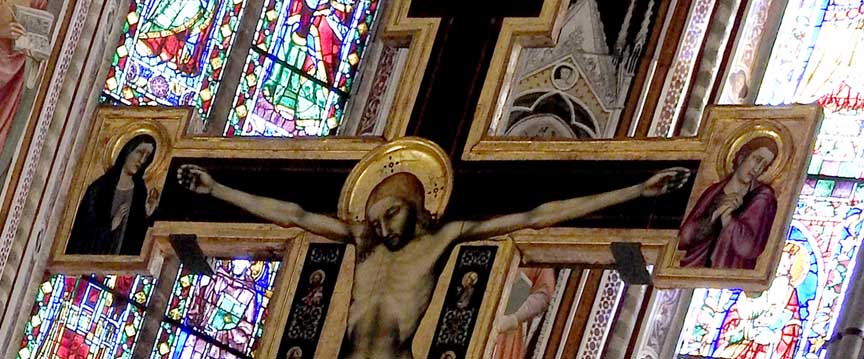 Rood Crucifix Left: Mary, mother of Jesus ... Right: St. John the Evangelist 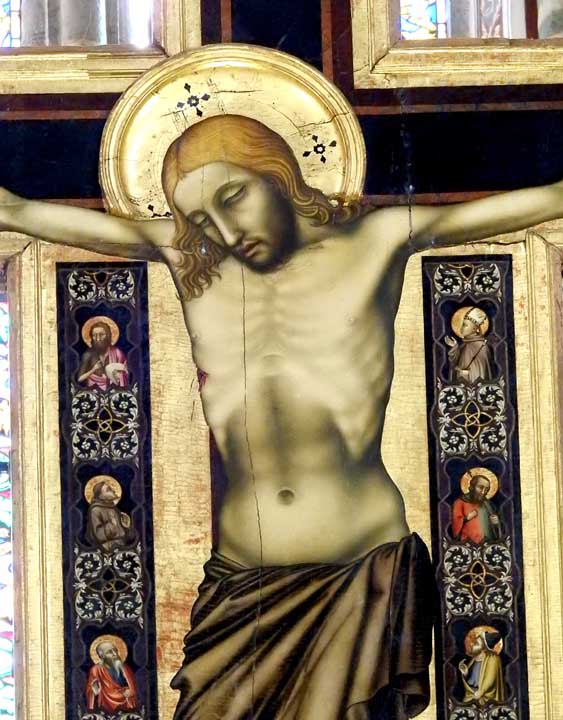 Rood Crucifix  Rood Crucifix |
Chancel
- ceiling Chancel - ceiling Chancel is located in a rounded apse on the other side of the nave ... Typical lancet windows behind the main altar ... Note rood cross suspended in mid air between the chancel and nave 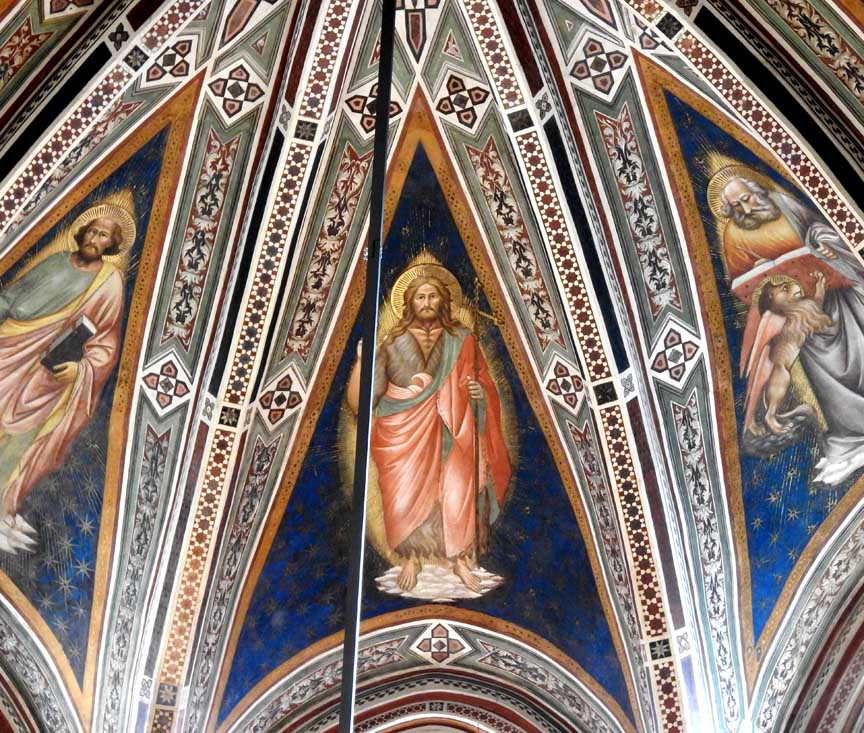 Chancel - ceiling St. John the Baptist, with a halo symbolizing sainthood, is depicted wearing a camel's hair robe and carrying a cross ... Two evangelists flank John ... Right side: Mark the Evangelist with his symbolic winged lion |
Chancel windows Chancel - stained glass windows Rood is between the nave and chancel ... Altar and windows are in the chancel  Chancel - stained glass windows Mary, mother of Jesus, crowned as Queen of Heaven is holding a Madonna lily ... Christ as Salvator Mundi  Chancel - stained glass windows Right: King David playing a harp 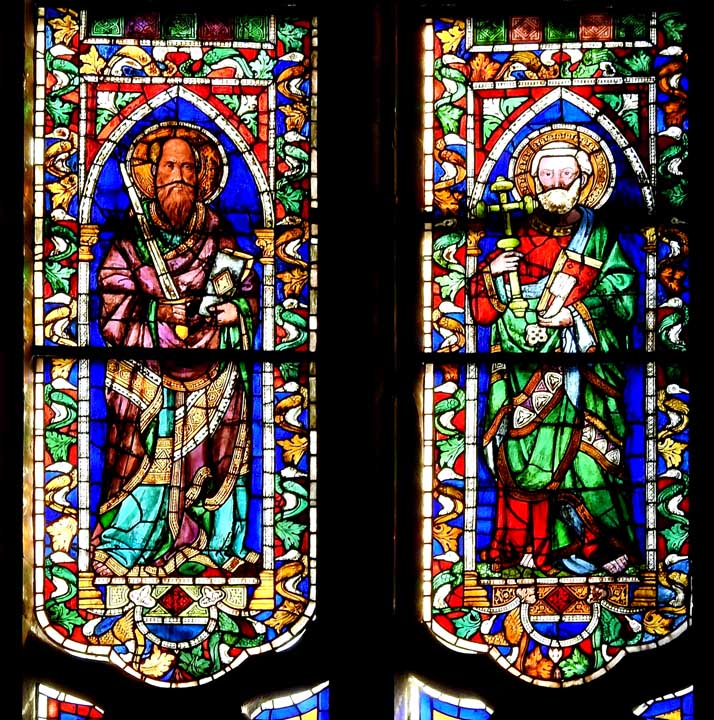 Chancel - stained glass windows Left: St. Paul with sword and Bible (his gospel) 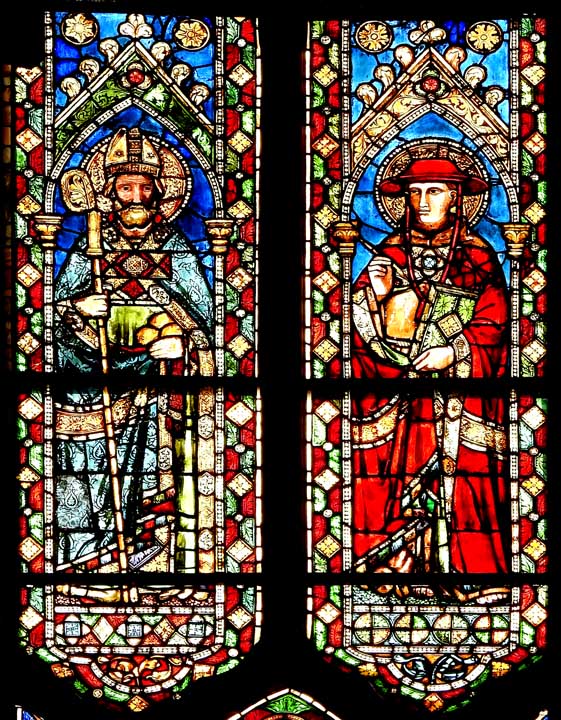 Chancel - stained glass windows Left: Pope wearing papal tiara and carrying crosier |
Chancel - fresco walls  Chancel - fresco walls "Behind the main altar we find the work of Agnolo Gaddi (c.1350-1396), frescoes depicting The Legend of the True Cross, the legend of the wood from the Garden of Eden becoming the Cross on which Jesus Christ was crucified, as it comes to us in the stories told in the book a Golden Legend. The book sought to compile traditional lore about all of the saints venerated at the time of its compilation (1280) and was considered a medieval "best seller" even out selling the Bible at one point. You can read the story as if it were a "fumetti" or portrayed in a comic book fashion; blocks of images that can be "read" starting from the top of the right hand wall to the bottom." - Visit Florence (online May 2020) 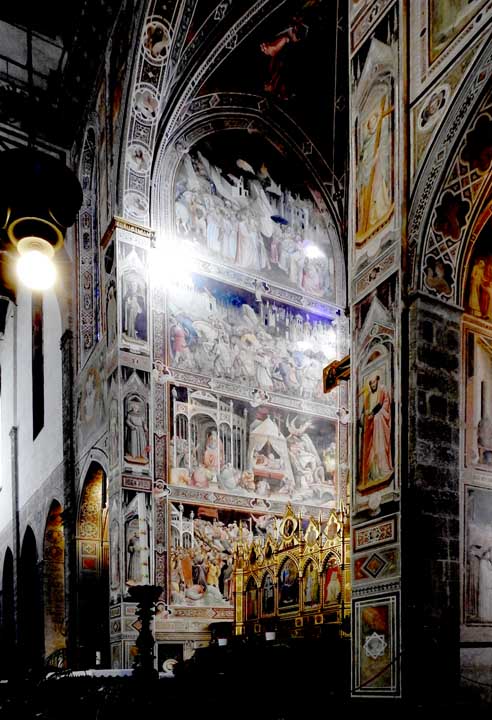 Chancel - fresco walls 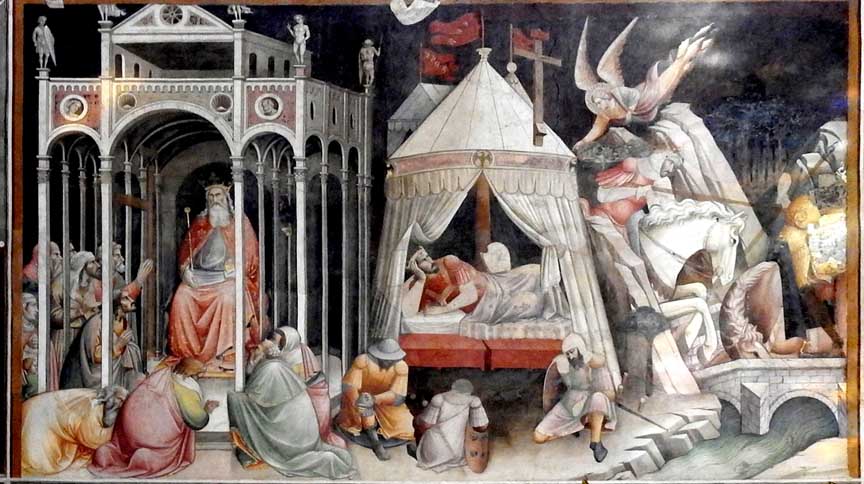 Chancel - fresco walls 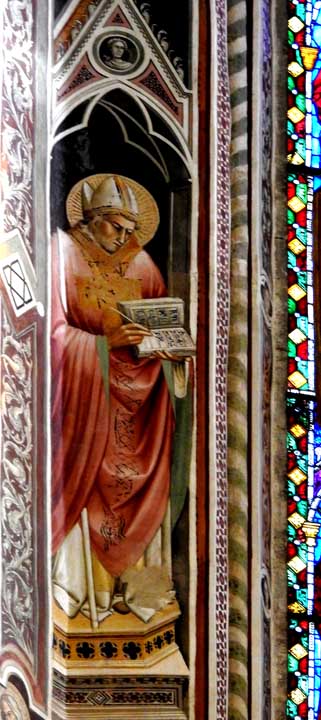 Chancel - fresco walls 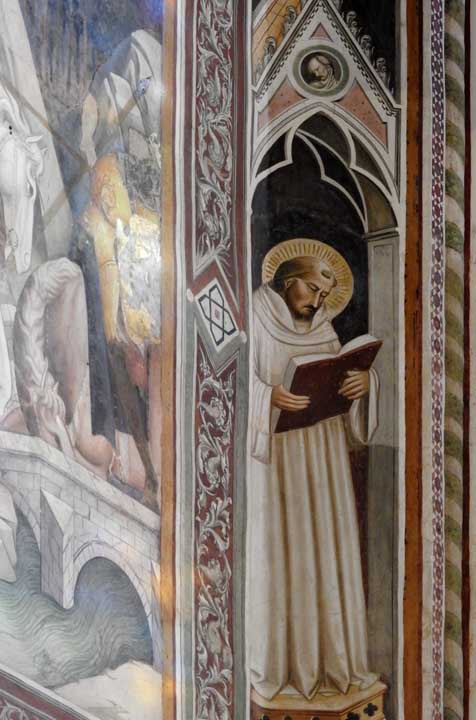 Chancel - fresco walls 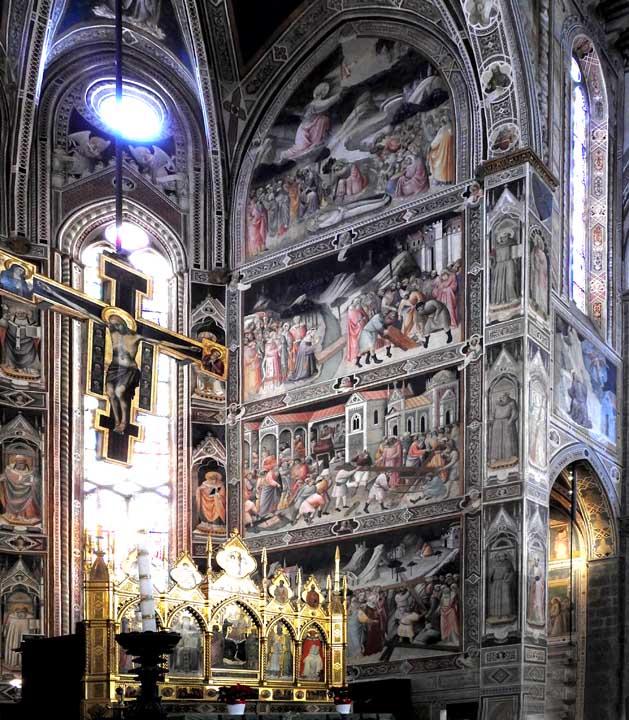 Chancel - fresco walls Note rood and main altar, detailed below: |
| Chancel - Altarpiece By Ugolino di Nerio c. 1325-28 Egg tempera on wood Located in the curved apse of the church "The early Italian High Altar
by Ugolino di Nerio for Santa Croce, the great Franciscan church of
Florence, is well-documented. With at least thirty-five sections in
all, this massive altar was painted and erected c. 1325-28. These
panels recall Duccio's sense of style and organization, as Ugolino was
still working with Byzantine line and colour. The altar was dismantled
shortly after 1566 and moved to the church's dormitory. By the 1830s,
most of its panel had been sold. Now the surviving panels are scattered
among museums and private collections.
"The original appearance of the altarpiece can be reconstructed on the basis of a nineteenth-century drawing attributed to Humbert de Superville. It is thought that the drawing is in essence accurate. " - Web Gallery of Art (online May 2020) 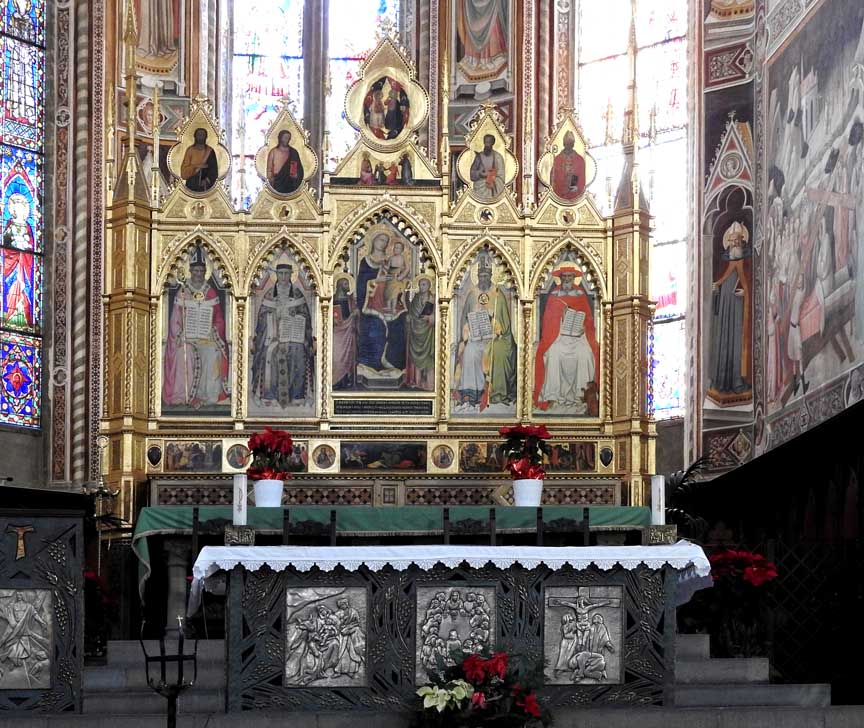 Chancel - Altarpiece  Chancel - Altarpiece Mary and Jesus Seated in heaven, surrounded by seraphim angels with six wings 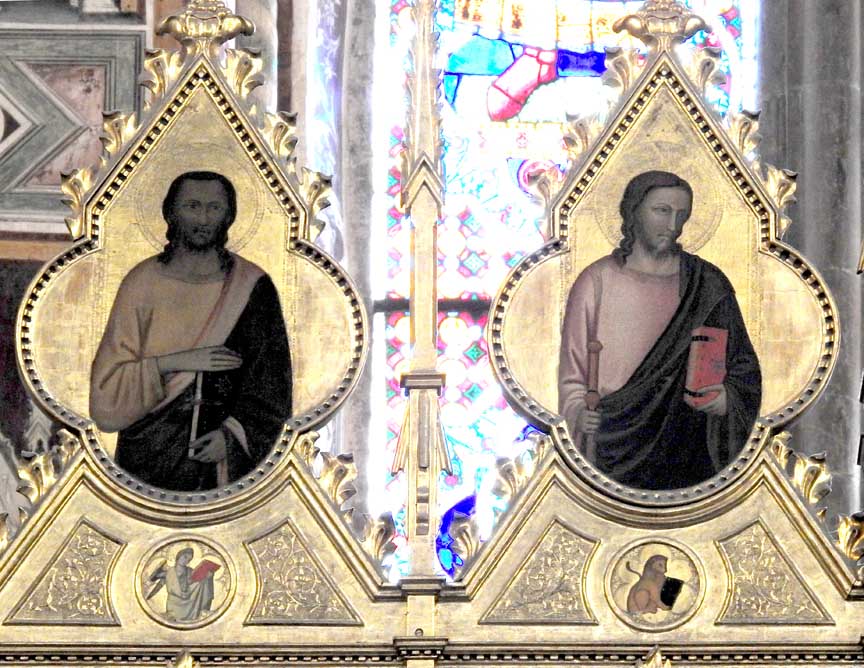 Chancel - Main altar Left top and bottom: Matthew the Evangelist with symbolic winged man in lower medallion ... Right top and bottom: Mark the Evangelist with symbolic winged lion in lower medallion 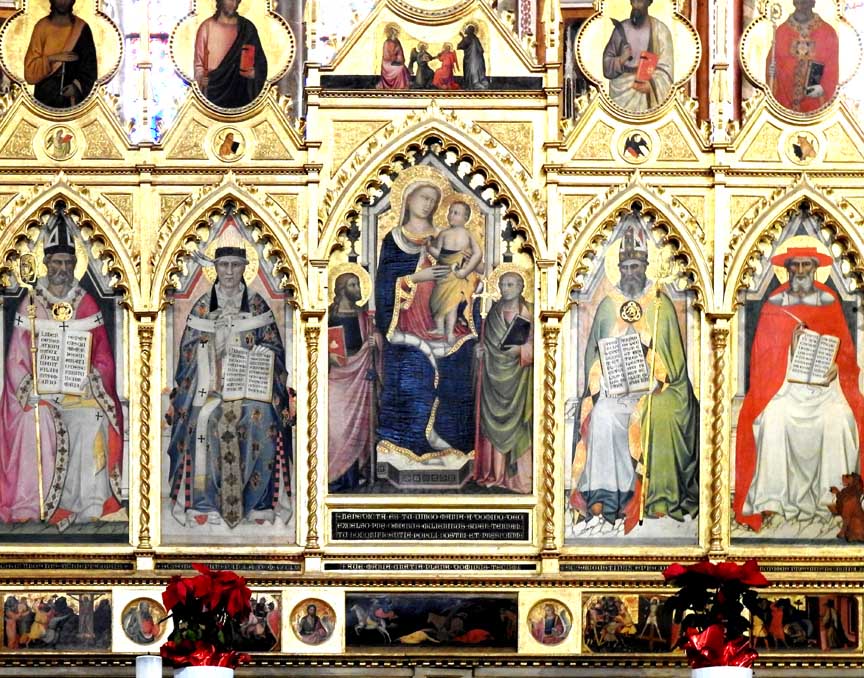 Chancel - Altarpiece Upper left: Evangelists Matthew & Mark ... Upper right: Evangelists Luke & John 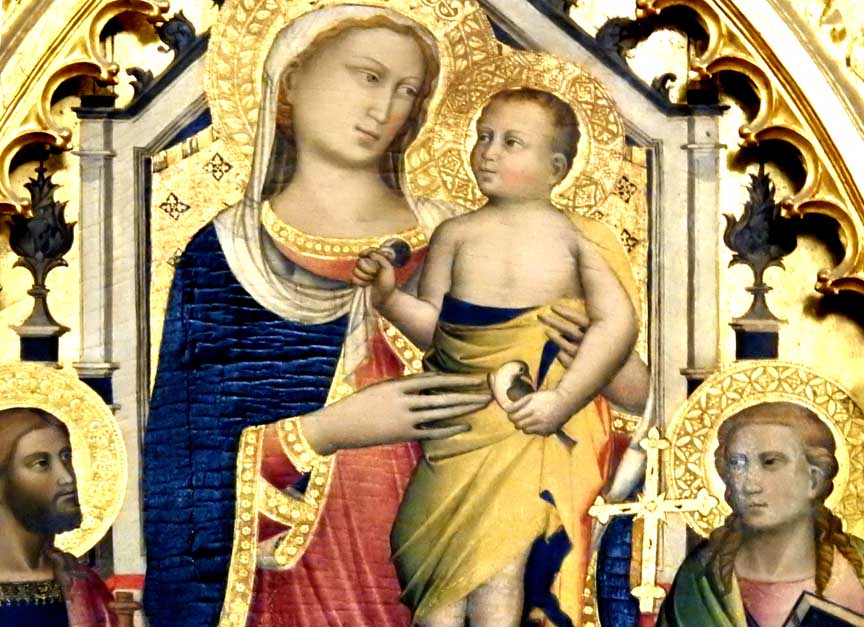 Chancel - Altarpiece Lower left: Christ ... Lower right: John the Baptist ... Center: Madonna and Child  Chancel - Altar Panels: Birth of Jesus ... Last Supper ... Crucifixion |
